Board Delivers 'Recipe' to a Public Hungry for Guidance
Confined to a wheelchair by cerebral palsy, Karly Woodall of Meridian, Idaho, is unable to enjoy most playgrounds because of a lack of accessibility.
Peggy Greenwell of the U.S. Access Board in Washington, D.C., spearheaded the drive for the release of the Final Rule concerning accessibility at play areas.
Peggy Greenwell likes to think of them as a ‘recipe’- but one that must be flavored to taste. "We've provided the guidelines, but you, as a designer or an operator has to put it together."
Greenwell says, "We don't do that. People feel like we should, but that's not our role. We're establishing a minimum."
The ‘minimum’ is a document with a maximum title: "Americans with Disabilities Act Accessibility Guidelines for Buildings and Facilities; Play Areas; Final Rule." It was released last October by the Architectural and Transportation Barriers Compliance after seven years of discussion, debate and review by Greenwell, her colleagues at the U.S. Access Board, and a public divergence of playground manufacturers, city and county government officials, landscape architects, child care operators and representatives from the disabled community. Although not yet law, the guidelines provide playground operators with a blueprint for an accessible playground. The hope, however, is that people will go beyond what the Final Rule calls for in terms of accessible components and surfacing.
The Final Rule states that all play structures with 20 or more elevated components should be equipped with a ramp.
“One thing we’ll never do, and we hope hope we’ll never see other people do, is say, ‘OK, here’s a playground that meets the minimum,’” Greenwell says. “Because what will happen is they will take that playground and replicate it all over the place. We don’t want to see that, and that’s not what I think people out there want.
“They want to go to a playground that’s interesting and challenging, and hopefully the accessibility part of it is seamless. You shouldn’t be able to just look at it and say, ‘I see where all the accessible things are.’”
Which means that in addition to recently adopted safety standards, playground equipment designers and landscape architects will have to take into account the ADA guidelines when constructing new playgrounds or updating older play areas, ramp access and transfer system access to elevated structures and access to soft-contained play structures.
Although the guidelines won’t become mandatory until they are incorporated by the Department of Justice the Final Rule states that ‘in the interim, the public may consult the new guidelines as a reference in providing access to playgrounds and play equipment.’
“It’s going to affect the whole industry,” Curtis Stoddard, chairman of the National Playground Contractors Association, says of the guidelines. “Everyone has to address it. It will change the way they are constructed and it will change the way playgrounds are budgeted.
“And we’re going to see it change the way kids play on playgrounds.”
Since the Final Rule was nearly a decade in the making, the playground industry was hardly caught off guard when it was published last fall. The Access Board released the proposed guidelines in 1998, then spent the next two years trying to clarify and simplify what had already been written, as well as listening to public comment at a hearing in Denver during a mandatory 90-day discussion period. The Board submitted its Final Rule to the Office of Management and Budget for clearance in July 2000, and the guidelines were published three months later.
Although it seems like a lengthy process, Greenwell says the seven-plus years it took to create the Final Rule was speedy in relation to other Access Board projects concerning golf courses and amusement parks.
Although Karly Woodall is unable to participate in some playground activities such as sliding down a slide, she is able to join her sister Laura at the top of a structure with ramp access.
A number of activities await both disabled and able-bodied children atop many new play structures.
“This one, even though it didn’t make it on a fast track, was on a faster track than others just because of the interest that people had in guidance. It was one of the most requested areas the board had. When the ADA was initially passed and people were told they had to make things accessible, this was a real area that people wanted guidance in.”
Greenwell says that, “for years, people have had an interest in making an accessible playground, but the ADA was unable to provide them with a concrete answer about exactly what qualified as being accessible. While that can now be found in black and white in the Final Rule, Greenwell’s biggest concern now is that playground operators won’t be able to understand the guidelines which she admits are ‘like Greek’ to someone not familiar with the language.
“Our rules are guidelines written like an ASTM standard or like a building code,” she explains, “There’s a certain format that’s used and for people who pick our stuff up cold, they’re like ‘What is this? I don’t get this line.’”
Transfer stations such as this make it easier for children in wheelchairs to gain access to a play structure.
In order to make the guidelines as clear as possible, Greenwell is working with Lani Wollwage of Kompan Inc., to put together a guidebook that will explain and diagram the Final Rule.
“We’re hoping that the manual will be something that will give people a simple guide,” Greenwell says, “because it’s complicated. It’s complicated. It’s not something that you can easily describe in a page.”
The Final Rule as released in the Federal Register, in fact, runs 32 pages long. The Access Board also released an amendment to the original rule in November in an effort to better clarify what is meant by a ground-level or elevated play structure. According to the guidelines, there must be a distinct ratio between the number of elevated and ground level components at each playground and the number of elevated play components will also determine the number of ramps and transfer systems which are required for each structure.
The Access Board also addressed the need for proper spacing, including the amount of space needed for a wheelchair to maneuver to and from a play component, the height and clearance of play tables, the height of entry points or seats, and the need for supports or grippable edges at transfer systems. In reference to soft-contained playgrounds, the Final Rule states that an accessible route must be provided to the entry points of each structure whether it be by ramp transfer system or platform lift, but does not address anything beyond the entry way.
Possibly the difficult portion of the guidelines to produce was the one concerning surfacing. It required a delicate balance between the existing safety standards and the need for a surface sturdy enough to support the maneuvering of a wheelchair. For wheelchair access, the Access Board refers to the ASTM standard F1951-99, which is a measurement of the physical effort required to move a wheelchair across a surface. As far as surfaces within the ‘use zone’-the area directly below and adjacent to the plat equipment-the Final Rule requires that operators follow the ASTM F1292-99 standard that is determined by drop testing.
With so many different types of surface materials now on the market, Greenwell says, “it's difficult to say exactly what will and won’t meet it the ADA guidelines.”
“Poured-in-place rubber surfaces meet it, there’s no question,” she says, “some engineered wood fiber products meet it, depending on the length of the fibers and how well they mesh together when they’re installed properly. People with sand aren’t going to meet it, wood chips aren’t going to meet it. I saw several new products at the NRPA Congress in Phoenix, some that used a shredded, rubberised product, that claim they meet it.
“But the requirement is complicated by the fact that we’re saying you have to maintain it to this level, which is an issue with some of the looser, fill products such as engineered wood fiber you need to maintain it at the level you started with and for some places, depending on use, that could be daily.”
“So operators have a decision to make about what they choose here. If you’re going to choose a surface that requires a lot of maintenance to keep it at a level you’re required to have, then you better have the maintenance to support it. Otherwise, pick something else.’’
Of course, it’s not quite as simple as that when money-or a lack thereof- is involved.
“Cost was very much an issue throughout the development of this rule,” Greenwell says. “There’s been examples in the past where people have spent a lot of money ramping up to a structure, only to be able to put a couple of play components on it because of the cost of the ramp.”
“So we sought to balance those.”
Although the new guidelines only pertain to new playgrounds or play areas that undergo improvements, most experts feel that the Final Rule will be readily accepted and adopted by everyone in the playground industry.
“They’re going to do whatever it says whether they like it or not,” says Dr. Fran Wallach, president of Total Recreation Management Services. “I think the industry and the profession will try its very best to provide as much accessibility as possible. I don’t think people are going to fight this.”
Helping disabled children become more involved in the play experience is the primary thrust of the recently released Final Rule.
MaryLou Iverson, a safety consultant with Iverson Associates, agrees.
“I haven’t heard any real negativity from anybody,” says Iverson, who sat in on many of the Access Board meetings. “I’ve already worked with a couple of groups who have said, ‘We can do more. We’re going to make the whole playground accessible.’”
“I’m sure there will be some people that will just try and do the minimum amount. It will just depend on the circumstances and the amount of money they have to spend.”
Although there are few people who feel like the Final Rule went too far, there are some that feel it didn’t go far enough. Ray Bloomer, Director of Education and Technical Assistance at the National Center on Accessibility, believes the guidelines “should have been stronger” and that the ratio of 20 or more elevated play components to trigger the requirements of a ramp is “a pretty high amount.” Bloomer says he understands the compromises that were involved in making up the rule, but that people should consider the long-term costs and what greater accessibility can mean to a specific child.
“When we look at a minimum design, we often times are affecting the degree of fun that a child might have at play,” he says. “People need to keep in mind when designing playgrounds and playground equipment that any time it is done at a minimal level, it means that children at a lower ability level are going to have a lesser degree of fun.”
There are a number of organizations throughout the country that are doing everything they can to make sure that every disabled child has a fully accessible playground within a short drive. But while these playgrounds are becoming more and more prevalent, they are expensive to build and are still few and far between. The Access Board’s Final Rule should go a long way towards correcting this deficiency, particularly if the Department of Justice, as it expected, makes it an enforceable law within the next year or two.
“Ten years ago, you could drive around and see a lot of post offices without a ramp,” Stoddard points out. “Now, anywhere in America you go, the post office has a ramp.”
“Someday that’s the way all playgrounds are going to be.”
Single copies of the ADA Accessibility Guidelines for Buildings and Facilities; Play Areas; Final Rule can be obtained at no cost by calling the Access Board’s automated publications order line (202)272-5434, by pressing 2 on the telephone keypad, then 1, and requesting publication S-39 ( Play Areas Final Rule) Persons using TTY should call (202) 272-5449. Record name, address, telephone number, and request publication S-39. The guidelines are available in alternate format upon request. Persons who want a copy in an alternate format should specify the type of format (cassette tape, Braille, large print or ASCII disk). The Final Rule is also available on the Board’s internet site at www.access-board.gov/play/finalrule.html



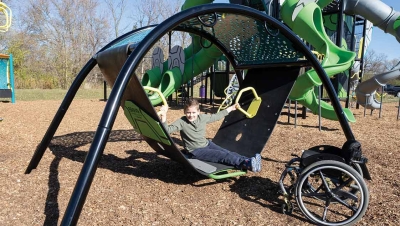
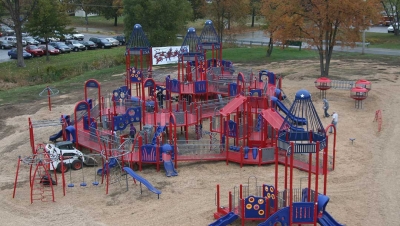
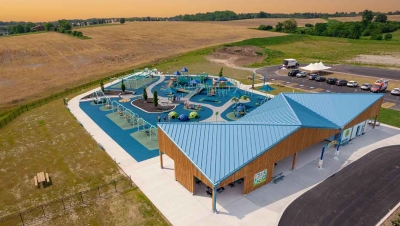




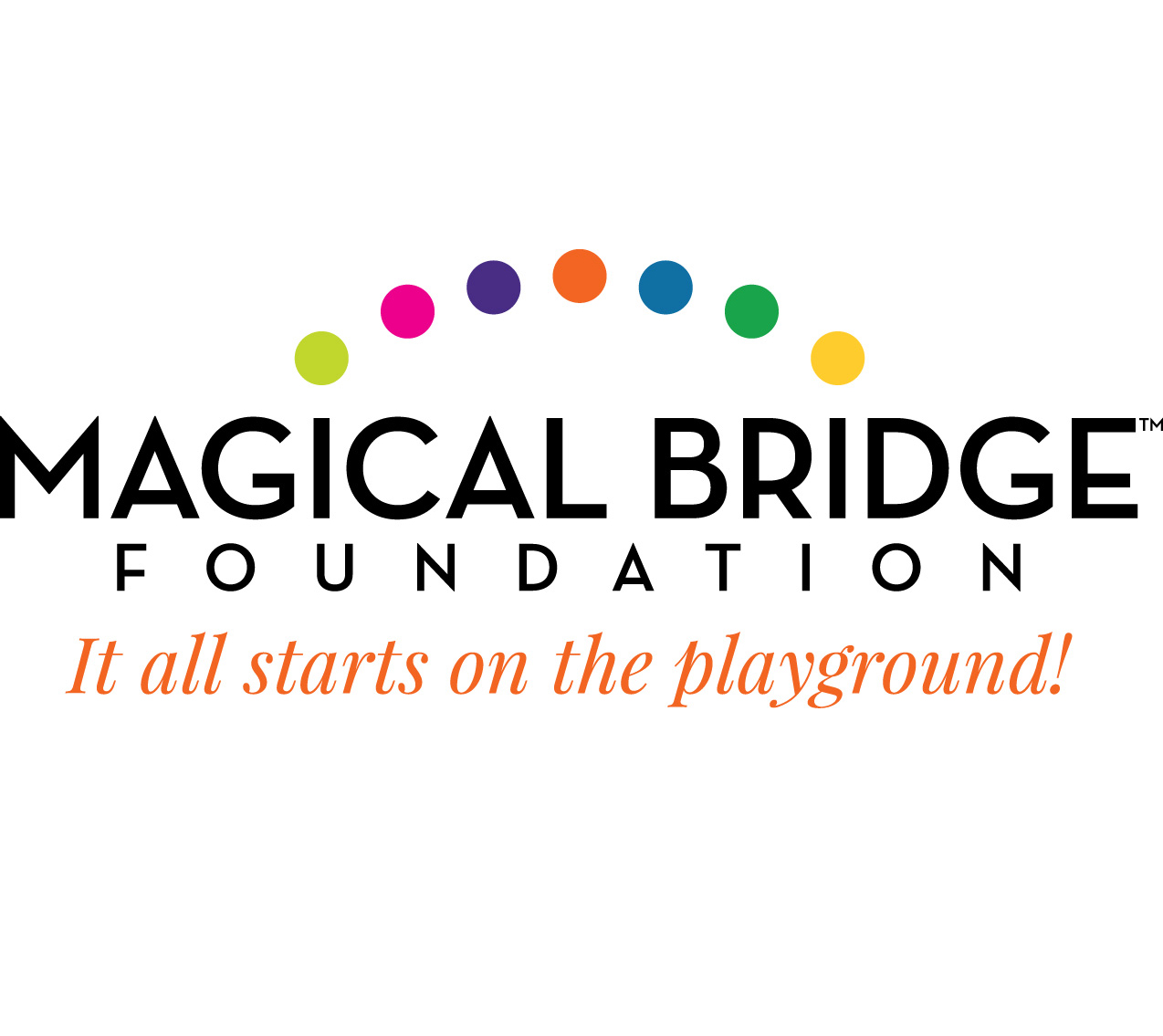

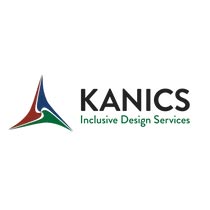
Add new comment